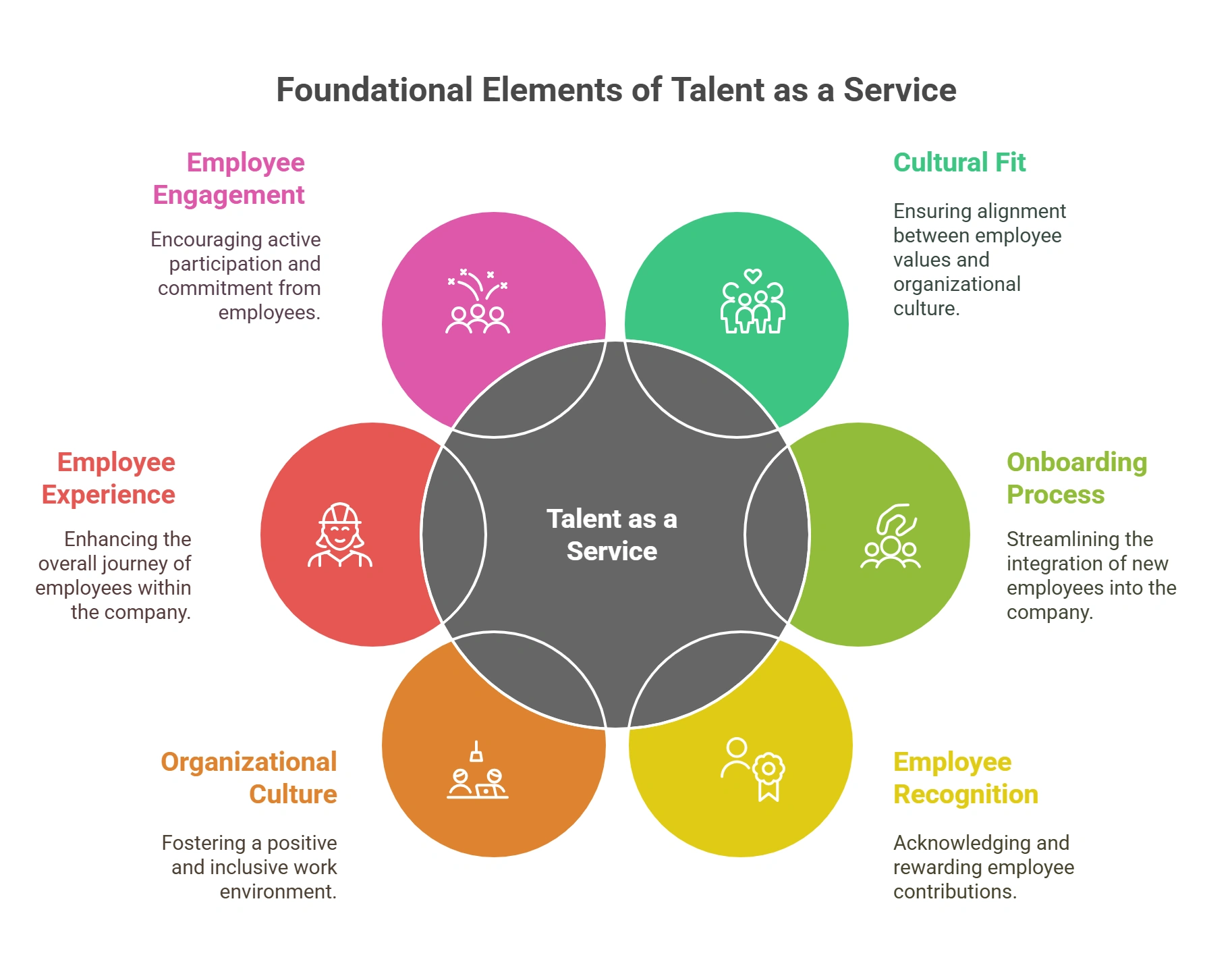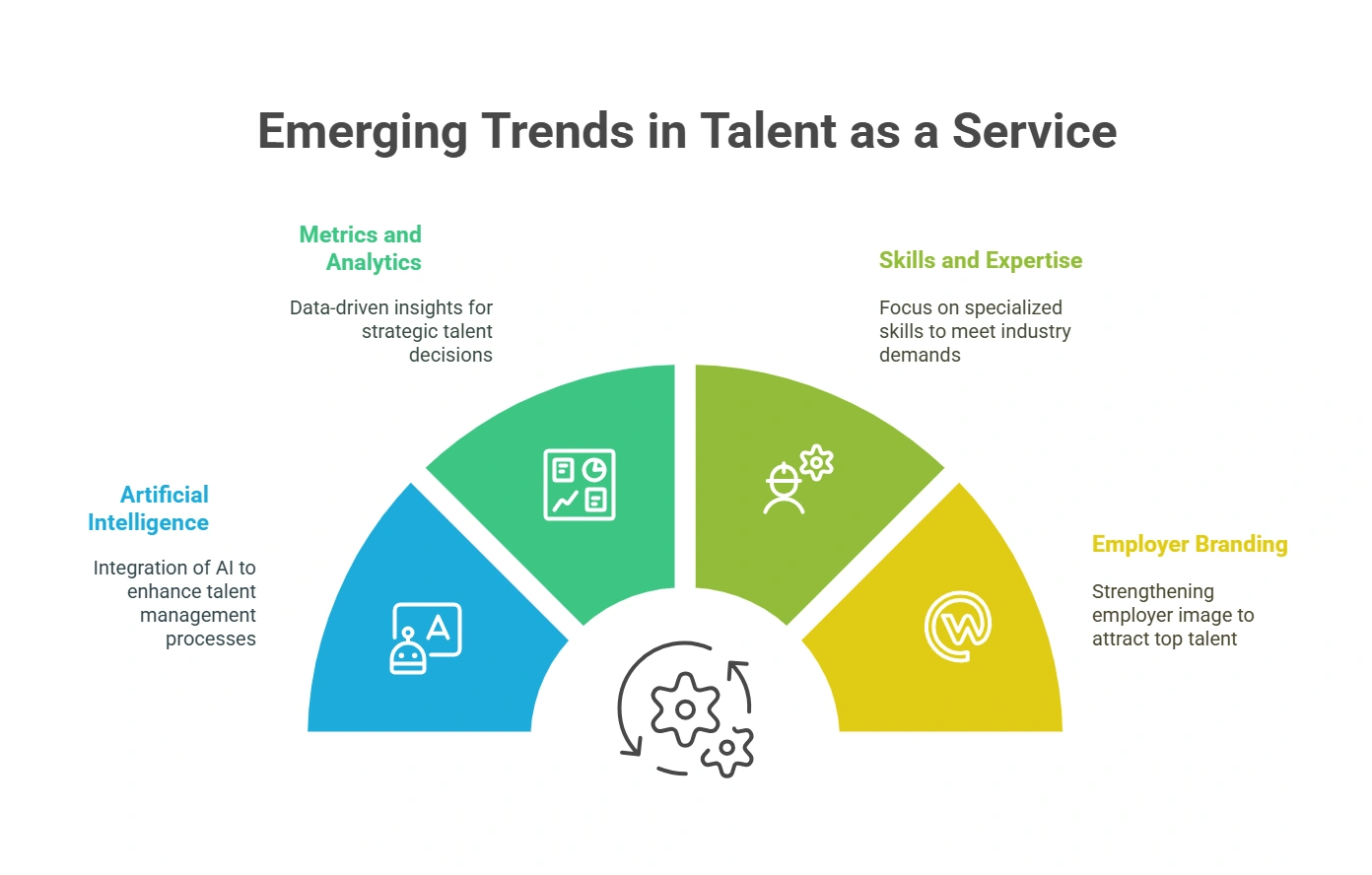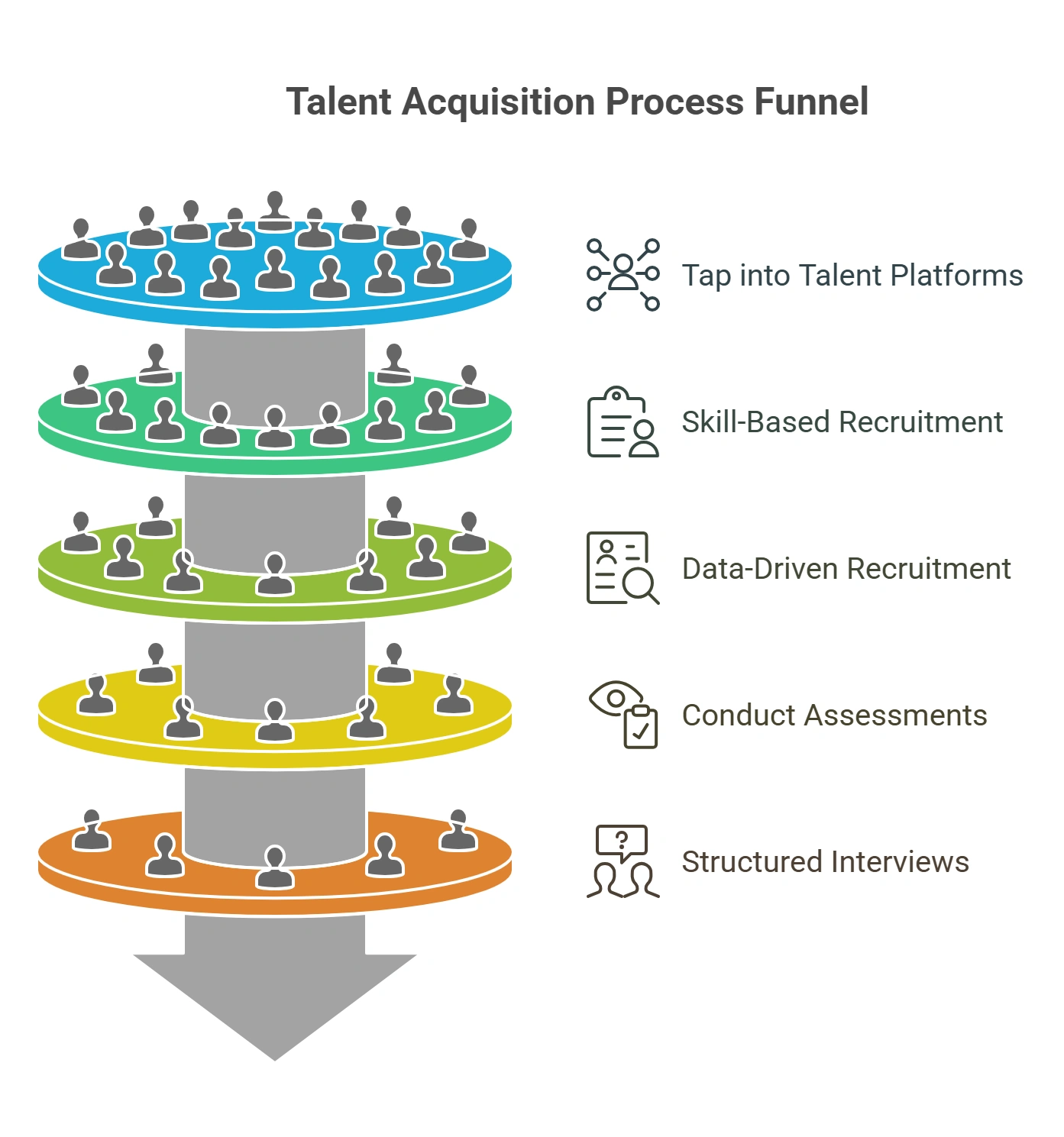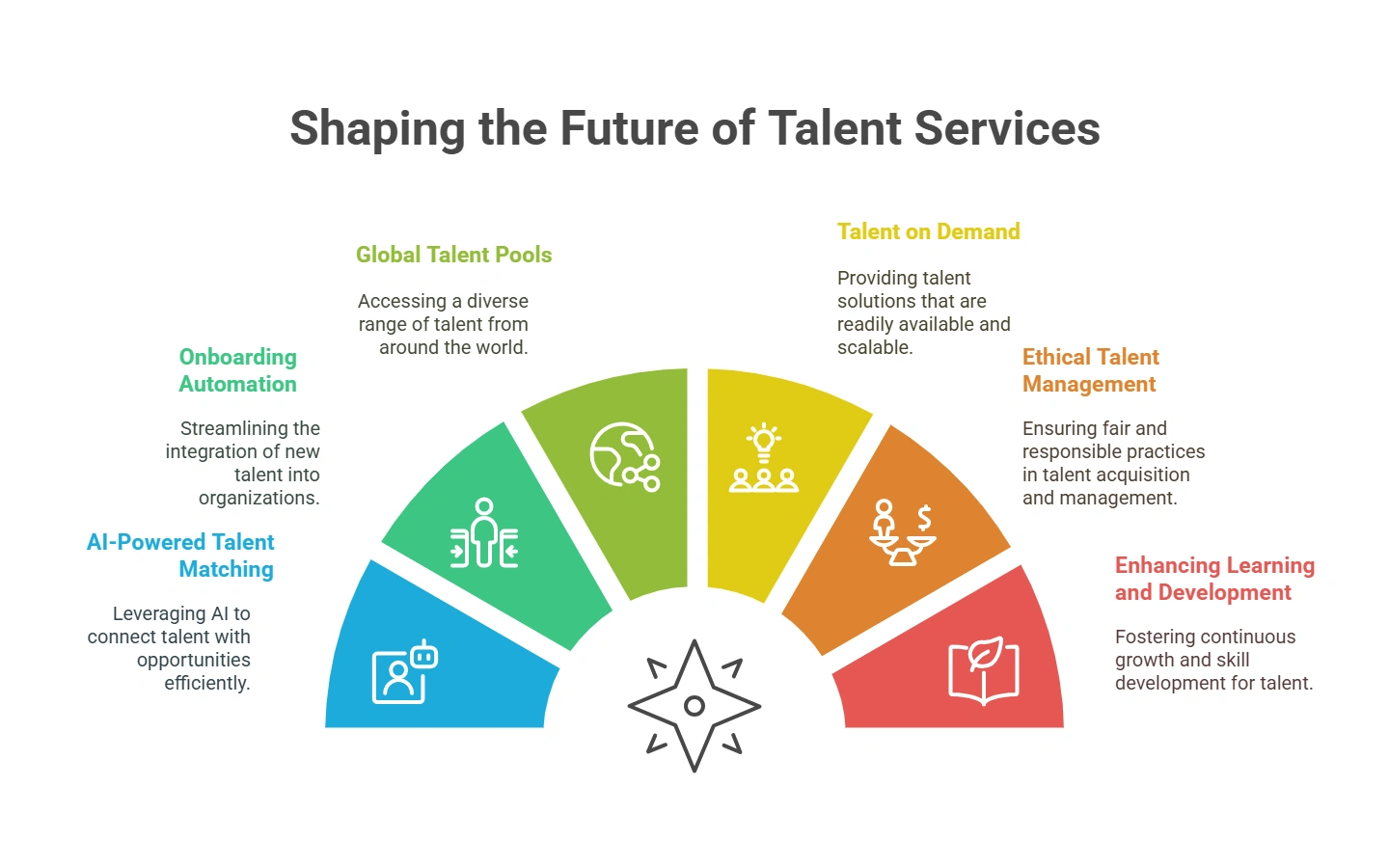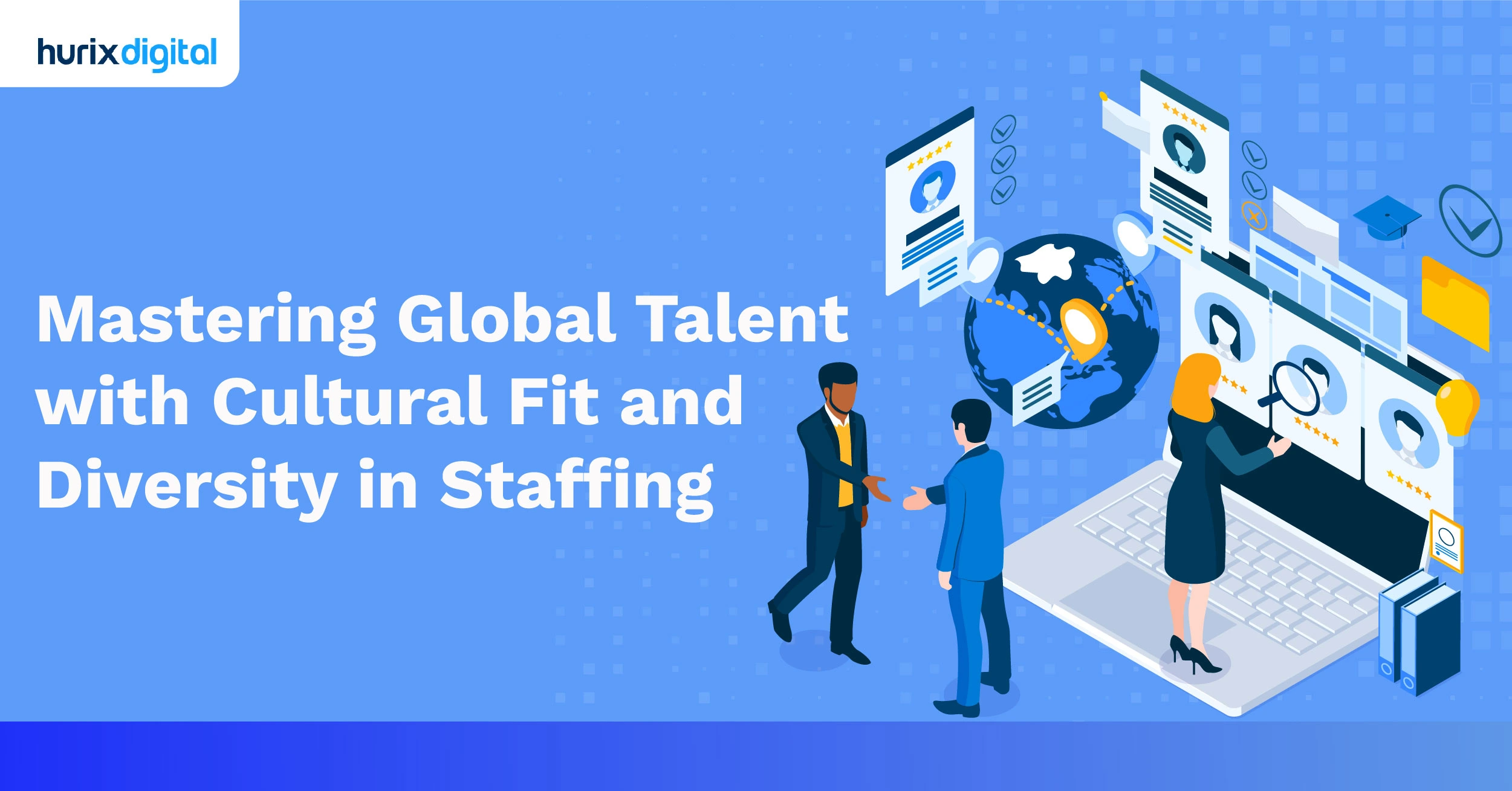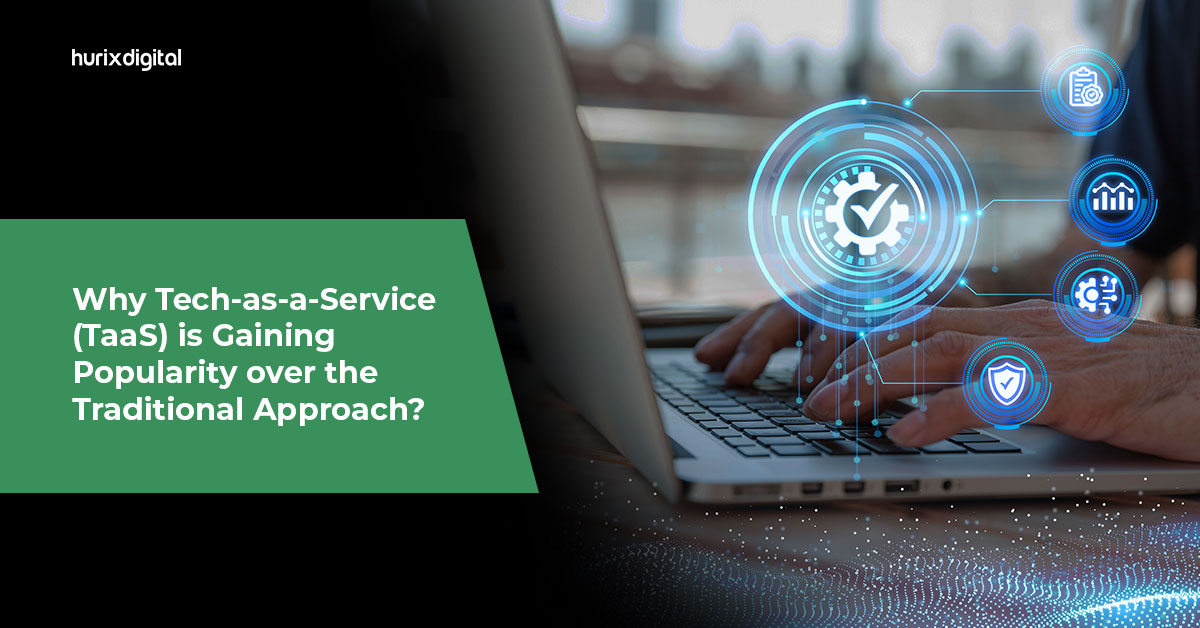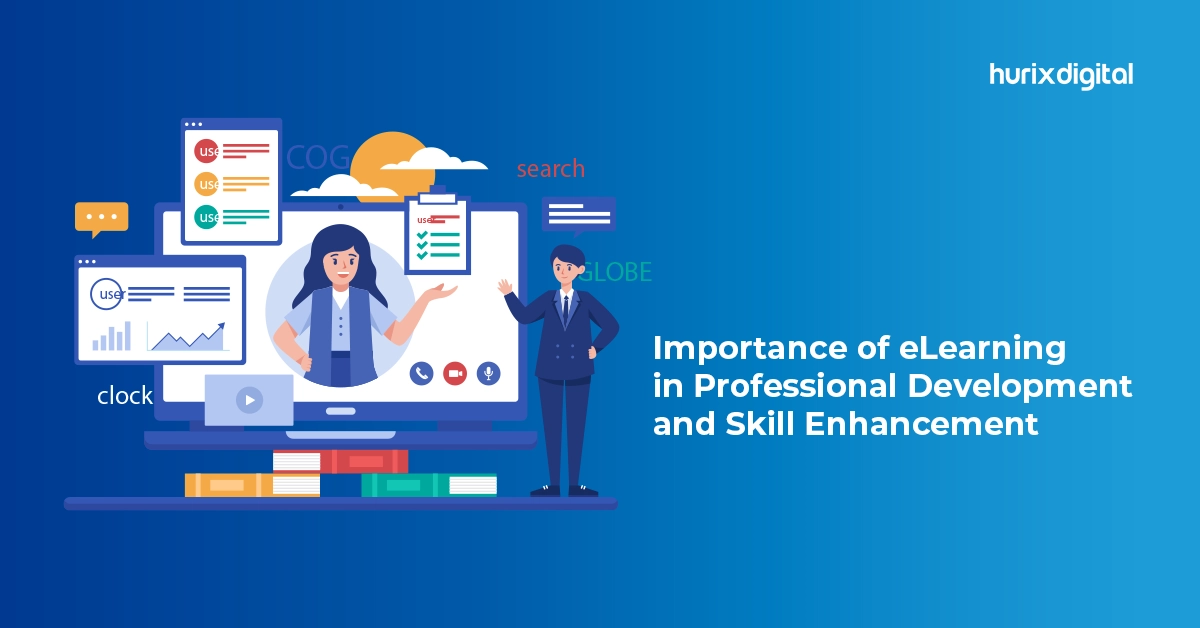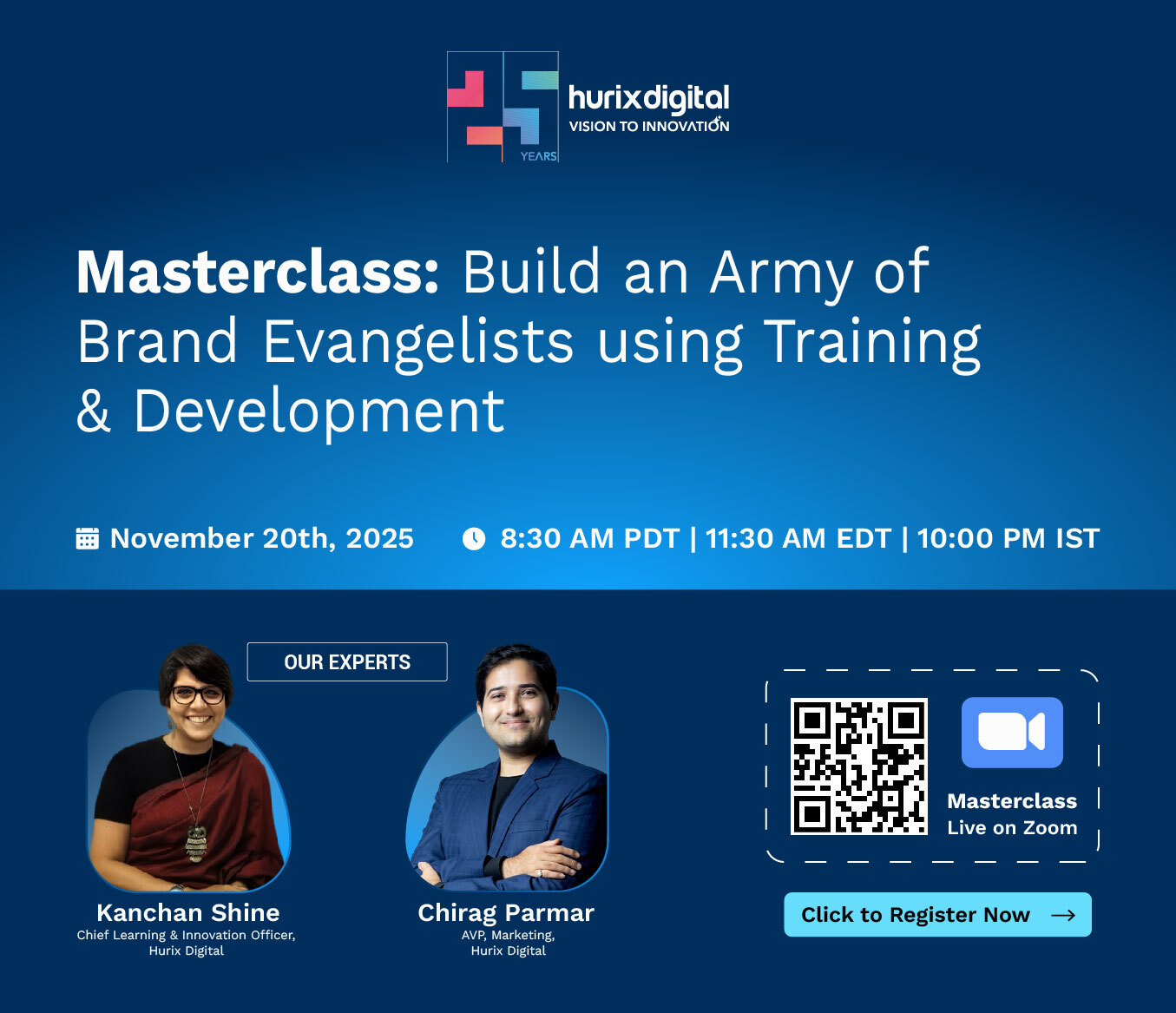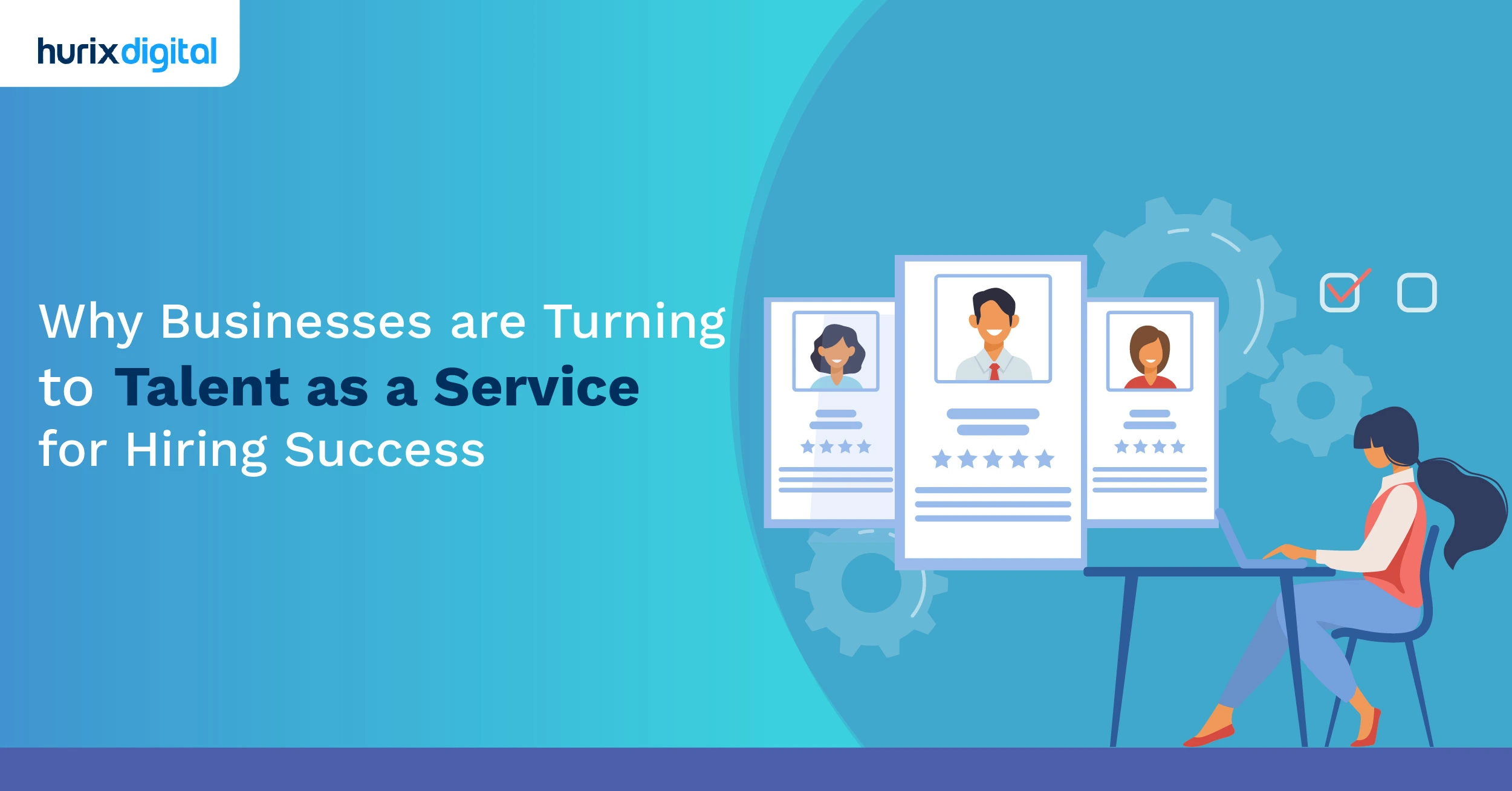
Why Businesses are Turning to Talent as a Service for Hiring Success
Summarize with:
In 2025, the hiring landscape is evolving—with Talent as a Service leading the way, organizations are reimagining onboarding to boost employee engagement and prioritize culture fit like never before.
Whether you’re a business owner, team leader, or budding entrepreneur, finding the right talent is paramount. Talent as a Service is a game-changer, providing an efficient way of acquiring, developing, and retaining the skilled people that your organization needs.
The talent as a service marketplace is projected to grow from an expected value of US$387.0 million in 2022 to US$1,173.6 million by 2032, at a compound annual growth rate (CAGR) of 11.7%.
The amalgamation of intelligent personnel management and artificial intelligence (AI) is revolutionizing talent as a service, optimizing assignments, and elevating the applicant experience.
Table of Contents:
- What is Talent as a Service (TaaS)?
- Key Principles of Talent as a Service
- 4 Key Emerging Trends in Talent as a Service (TaaS)
- Top 5 Benefits of TaaS
- How to Hire the Right Talent Using Talent as a Service?
- How to Retain Talent in 2025?
- Importance of Professional Development in Talent as a Service
- Future of Talent as a Service (TaaS) in 2025
- Summing Up
What is Talent as a Service (TaaS)?
TaaS refers to the quick supply of highly skilled workers on demand, made available to businesses via a cloud-based platform. Like SaaS, TaaS aids businesses in reducing expenses and boosting productivity.
Talent as a Service (TaaS) operates through collaboration with an outside supplier that specializes in hiring. The TaaS provider plans to work thoroughly with the company to comprehend its hiring requirements before developing a special strategy to locate qualified applicants.
The Talent as a Service procedure normally operates as follows:
- Assessment: The TaaS provider will collaborate with the company to identify the roles needed, the expertise and ability levels needed, and any other particular requirements.
- Finding the most suitable Candidates: To locate the best candidates, the TaaS supplier will employ various procuring techniques, such as networking sites, professional associations, and job boards.
- Applicant Screening: The TaaS provider will interview prospects to ensure they align with the company’s values and possess the required abilities and expertise.
- Interviewing Applicants: The TaaS supplier will hold preliminary interviews to determine an applicant’s skills and fit for the position.
- Onboarding and Learning: The TaaS provider will manage the onboarding and training process for the selected candidates to ensure they’re prepared to start working immediately.
- Continuous Support: To guarantee a smooth transition, the TaaS supplier will continue to help the company and the newly hired employees.
Key Principles of Talent as a Service
Talent as a Service is a fresh way of getting the right talent while keeping up with the industry standards. You can consider it as a digital talent store where your business can easily choose the skills needed based on the requirements.
Now, the question remains: how can you get the most out of this service? Let’s have a look at the concept in depth:
1. Prioritizing Cultural Fit
Talent as a Service (TaaS) is key for businesses keen on constant growth and innovation. One vital aspect of TaaS is to prioritize cultural fit when hiring. This means ensuring people’s ambitions, values, and attitudes match the company’s ethos.
Understanding a candidate’s approach, conduct, and attitude toward working in a team is important:
- Create thoughtful yet practical interview questions to check their compatibility with the company’s culture.
- Make team interaction part of the interview.
Applying this method ensures a seamless onboarding process and increases employee engagement, resulting in a satisfactory employee experience.
2. The Onboarding Process
One key step to keeping new hires happy and successful is perfecting your onboarding process. This shouldn’t just be a quick rundown of the rules and job tasks.
It’s a great opportunity to immerse new employees in your company’s vibrant organizational culture.
- Kick-off with an exciting, welcoming program that shows what your company is all about.
- Set up a buddy system where a seasoned colleague helps guide the new hire. This helps with those early-day jitters and questions.
- Ensure your new hires are comfortable and sure about what is expected from them. This allows for no frustration or confusion.
3. Employee Recognition
Talent as a Service greatly values praising staff for their hard work. This makes employees feel good, sparks employee engagement, and adds to an amazing employee experience.
Here are some ways to appreciate your employees:
- Quick thanks: When you notice good work, say thanks immediately. It motivates employees to keep doing well.
- Praise in public: Sharing an employee’s achievement in front of others boosts their confidence and inspires other team members.
- Custom awards: If you can, give rewards that suit each employee’s likes or hobbies. It makes them feel special.
These employee recognition practices can nurture a healthy organizational culture and help you keep your best people.
4. The Organizational Culture
Understanding the role of organizational culture in hiring or retaining talent is crucial. It goes beyond simply employing people. It includes creating a work environment that promotes professional development, propels employee engagement, and enhances the employee experience.
- Offering professional development opportunities helps keep top employees happy and updated according to the market standards.
- A workplace environment that appreciates everyone’s effort and consistently offers employee recognition can significantly boost their happiness at work and efficiency.
- Building a positive work environment hinges on open, honest communication. In other words, you prioritize the Talent as a Service model by fostering a strong organizational culture.
5. Enhancing Employee Experience
We live in a digital age, and work is changing. Therefore, we should adapt our ways to improve our employees’ work lives.
A big part of creating a Talent as a Service model is creating a positive work environment that puts employee well-being and growth first. We can do this by:
- Promoting employee engagement strategies that value everybody’s perspectives, teamwork, and active organizational involvement.
- Creating more chances for professional development improves employees’ abilities, fuels their growth, and might even reveal new talents within your team.
6. Boosting Employee Engagement
Boosting employee engagement is a great technique to keep your best talents. It’s not just about celebrating with fun office events. It’s more about clear conversations, helpful feedback, and making the workers feel they’re part of something valuable.
- Make communication straightforward. Let your employees talk openly. This builds trust and raises engagement.
- Offer regular, constructive criticism. Your team needs to understand their performance and the ways to improve it.
- Give a feeling of purpose. If workers sense their work is important, they’re more likely to stay engaged.
4 Key Emerging Trends in Talent as a Service (TaaS)
The continued application of cutting-edge technology and creative HRM techniques has contributed to the rapid expansion of talent as a service.
Here are the key elements of TaaS that are bringing about significant changes in the hiring model and their potential future implications:
1. Incorporation of Artificial Intelligence
AI is one of the fields of talent acquisition programs that is expanding at a rapid pace. Natural language processing (NLP), chatbots, job-posting channels, and intelligent talent systems are a few instances.
Artificial Intelligence (AI) can do tasks like screening resumes for particular skills, in contrast to robotic process automation (RPA), which carries out tedious, manual duties. When paired with RPA, AI can assist recruiters in analyzing and interpreting documents, reviewing job boards, and more. As a result of ChatGPT’s growth, many businesses have added features to their recruiting software, like the ability to generate interview questions.
While NLP assists users in creating job postings, provides advice on how to tailor the postings to be more appealing to candidates, and enhances chatbot response precision, recruitment chatbots may assist applicants by offering additional information about job openings. By studying user behavior, machine learning can help increase the software’s effectiveness.
2. Use of Metrics and Analytics
Many hiring managers are quickly adopting analytics, and this is still a significant trend that will influence how businesses establish their hiring model. By integrating analytics into talent acquisition procedures, organizations can find areas for development, make better decisions, and spend less on hiring new employees.
Recruiters can obtain metrics from analytics like these:
- The hiring source
- Estimated time to hire
- Job age (length of time it was available)
- Acceptance rate of offers
- Expense for each hire
- Cost of vacancy: The expense incurred by the company while an opening is unfilled
- Metrics about diversity and equality
Additionally, predictive analytics is in demand. This aids recruiters in projecting future patterns, such as anticipated duration to fill and interview approval rate. Predictive analytics, trend detection, and visualization are features in most recruiting software.
3. Increasing Emphasis on Skills and Expertise
Due to the use of AI, evaluating abilities and expertise and utilizing the results to find, evaluate, and match candidates to available positions is growing in popularity.
Certain HR software providers are increasingly incorporating employee characteristics like motivation, goals, and interpersonal skills into their systems for use in a range of procedures.
4. Surge in Employer Branding Trends
In a competitive labor market, employer branding has become a major recruiting trend in the past few years and is still a critical distinctive feature for businesses of all sizes.
In addition to applicants seeking employers who share their ideals and provide a rewarding work environment, many job seekers are also interested in remote work choices and professional growth prospects. Furthermore, candidates can find out more about a company’s work environment and conditions with greater ease thanks to online company review systems.
An organization’s capacity to draw in top talent, lower attrition, and raise staff morale can all be impacted by a strong employer brand. These days, a lot of businesses are making investments in their employer brands by using techniques like social media presence and worker testimonials.
Top 5 Benefits of TaaS
Here are the top-rated benefits of talent as a service that businesses must consider:
- Time Savings: By handling every step of the hiring procedure, the TaaS solution saves the company time and financial resources that would otherwise be spent concentrating on other projects.
- Lower prices: Since TaaS eliminates the need for hiring, training, and HR staff, it may be a more affordable choice for businesses.
- Access to the Best Skills: It can be challenging for organizations to locate and draw in top talent single-handedly. TaaS providers, on the other hand, have vast resources and expertise in doing just that.
- Scalability: TaaS is a scalable and adaptable solution because its suppliers can swiftly scale up or down their offerings in response to the company’s hiring needs.
- Decreased Risk: Since TaaS providers find and vet candidates, they take on a portion of the risk associated with hiring, lowering the possibility that an unsuitable applicant will be hired.
How to Hire the Right Talent Using Talent as a Service?
Talent as a Service is changing the way companies hire talent.
Here are step-by-step strategies for hiring the right talent:
1. Step 1: Define Your Talent Needs
Begin with your particular requirements for skills, expertise, and roles. Define the scope of work, project duration, and desired outcomes to attract the right candidate.
2. Step 2: Tap into Talent Platforms
Use TaaS platforms to tap into a global talent pool. These platforms offer advanced filters and AI-matching tools to streamline the search process. Share project information and use platform algorithms to find a candidate who fits the company’s requirements.
3. Step 3: Skill-Based Recruitment
Skill-based recruitment refers to hiring employees based on relevant experience rather than traditional employment requirements such as academic certificates and diplomas.
Evaluate candidates based on their practical skills and ability to deliver results. Use skill assessments, project-based tasks, and real-world scenarios to test their expertise. This ensures that your hiring talent aligns perfectly with your project needs and expectations.
4. Step 4: Data-Driven Recruitment Tools
Implement AI-based tools that analyze candidate profiles, skills, and performance to make the correct hiring decision. Predictive hiring solutions can help identify candidates who have the potential to succeed in your organization.
5. Step 5: Use Assessments
Deliver specific assessments, coding challenges, case studies, or simulations to assess a candidate’s practical skills. Simulations are the best way to test a candidate’s real-life problem-solving skills.
6. Step 6: Conduct Structured Interviews
Conduct a structured interview to avoid bias and provide consistency. Prepare standardized questions related to the desired skill or characteristic. A structured interview is twice as predictive of job performance as an unstructured one.
7. Step 7: Review and Optimize Your Recruitment Process
Review your recruitment process periodically for weaknesses. Use metrics such as time-to-hire, cost-per-hire, and retention rates to fine-tune your strategy.
How to Retain Talent in 2025?
Here’s how organizations can retain the best talent in 2025 using talent as a service:
1. Invest in Continuous Learning
Upskilling and reskilling are important for the organization as they improve the competence of its workforce, just as much as they aid the employees by promoting their career advancement. Here are some best practices:
- Provide customized learning paths through solutions such as LinkedIn Learning or Coursera.
- Provide mentorship opportunities by connecting the experienced and junior team members for knowledge transfer.
- Conduct training in-house or collaborate with professionals from other industries for specific upskilling.
2. Promote Engagement and Inclusion
Engaged employees feel valued and included and thus tend to be more committed to their organization. A positive workplace culture leads to satisfaction and decreased turnover. Conduct team-building activities to improve relationships and a sense of community.
3. Establish Feedback Channels
An open feedback culture and trust encourage employees to voice concerns and be heard, leading to increased satisfaction and retention. Use surveys regularly to identify employees’ pain areas and determine potential issues.
Importance of Professional Development in Talent as a Service
Talent as a Service is a popular way businesses care for the people who work for them. They want to keep their employees happy and help them grow.
One way they do this is by focusing on professional development. When companies help their employees learn more and do better in their jobs, their employees want to stay.
Below are some other ways:
- Creating Learning Maps: Companies can create roadmaps that demonstrate, present, display employees the potential progression of their jobs. This gives the team a clear vision of their career path and how to excel.
- Encouraging Continuous Education: It’s key that all employees pursue constant learning. Organizing activities such as conferences, webinars, online courses, or projects helps them stay updated with the latest industry standards.
- Nurturing Potential Leaders: Companies can set up training programs to groom new leadership. With such initiatives, employees feel motivated and keen to take on more responsibilities as they might be able to lead the team or company.
Future of Talent as a Service (TaaS) in 2025
Since the world’s business community evolves rapidly in this fast-paced globe, Talent as a Service (TaaS) will transform business workforce strategies.
Here’s how TaaS will rule 2025 and the future of talent acquisition:
1. AI-Powered Talent Matching
Artificial intelligence improves the speed and accuracy of talent selection by considering candidates’ skills, experience, and compatibility with organizational needs.
Advancements in 2025:
- Platforms powered by AI will bring real-time matching to cut hiring time.
- Predictive analytics will forecast workforce needs and ensure that companies start hiring early.
- Through AI-driven TaaS, a specialized blockchain developer is recommended within hours to a tech company for urgent project work.
2. Onboarding Automation
Automation streamlines the hiring process, from contract generation to compliance checks, ensuring smoothness for employers and talent.
- Automated tools will make onboarding easier and reduce administrative costs.
- AI chatbots will answer FAQs, thereby decreasing human interference and saving time.
3. Global Talent Pools
Global connectivity, enhanced by advanced communication tools and remote work technology, allows businesses to transcend geographical boundaries.
2025 Developments:
- Remote collaboration tools with VR will make global teamwork easy and smooth.
- G will help in real-time interaction and, thus, in handling distributed teams.
4. Talent on Demand
As industries become more tech-driven, the demand for niche expertise increases. TaaS enables companies to get access to specialized professionals as needed.
Advancements in 2025:
- Micro-skills-based talent segmentation in platforms will allow accurate hiring.
- Short-term, project-based job dominance will be seen, but highly specialized areas such as AI ethics, quantum computing, and sustainability will be more significant.
5. Ethical Talent Management
As the gig economy grows, ethical issues like fair pay, inclusion, and adherence to labor laws will emerge.
Advances in 2025:
- TaaS platforms will leverage blockchain to be transparent and secure in payment systems.
- Diverse tools promoting inclusive recruitment and hiring practices will follow.
6. Enhancing Learning and Development
TaaS platforms will become centers of upskilling and reskilling to ensure talent remains competitive.
Advancements in 2025:
- On-demand microlearning modules will be integrated into TaaS.
- Employers will invest in training for gig workers to meet their requirements.
Summing Up
Organizations aspiring to formulate robust strategies for Talent as a Service should place professional development at the heart of their approach.
This commitment to employees’ ongoing development and progression not only enhances their contentment and efficiency but also sets the organization apart as a coveted employer in their sector.
This is where Hurix Digital can help. We help organizations design tailored, scalable TaaS solutions that align with their goals. Our aim is to empower businesses to build agile, future-ready teams and drive lasting success. If you have any questions, feel free to contact us—we’re here to help.
Summarize with:

Vice President & SBU Head –
Delivery at Hurix Technology, based in Mumbai. With extensive experience leading delivery and technology teams, he excels at scaling operations, optimizing workflows, and ensuring top-tier service quality. Ravi drives cross-functional collaboration to deliver robust digital learning solutions and client satisfaction
 Upcoming Masterclass | Build an Army of Brand Evangelists using Training & Development | November 20th, 8:30 AM PDT | 11:30 AM EDT | 10:00 PM IST
Upcoming Masterclass | Build an Army of Brand Evangelists using Training & Development | November 20th, 8:30 AM PDT | 11:30 AM EDT | 10:00 PM IST

